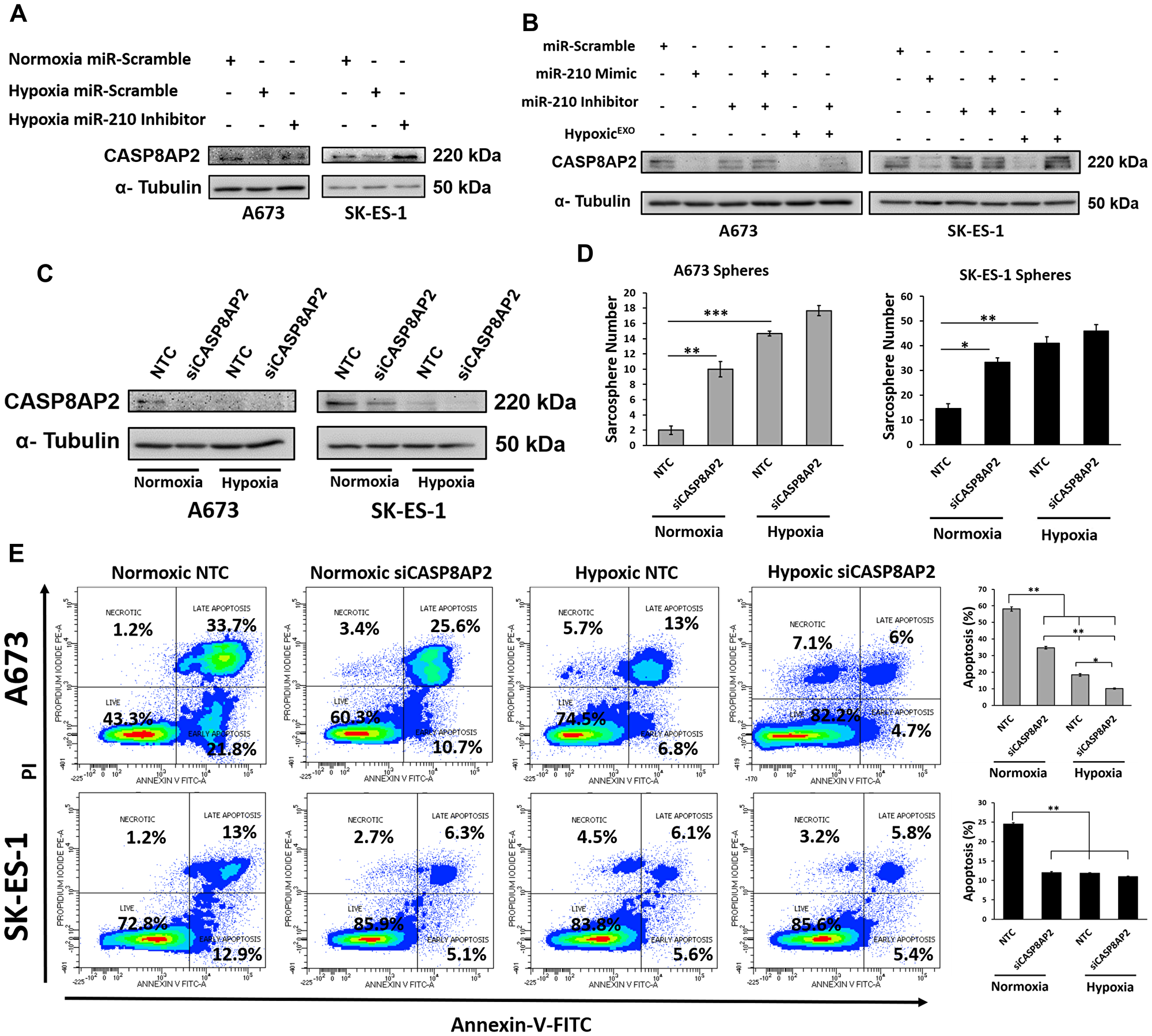The cover for issue 40 of Oncotarget features Figure 5, "miR-210 silences the proapoptosis member CASP8AP2," by Kling, et al. which reported that hypoxic Ewing's sarcoma cells release exosomes that promote sphere formation, a stem-like phenotype, in EWS cells by enhancing survival.
Analysis of the hypoxic exosomal miRNA cargo identified a HIF-1α regulated miRNA, miR-210, as a potential mediator of sphere formation in cells exposed to hypoxic exosomes.
The knockdown of HIF-1α in hypoxic EWS cells led to decreased exosomal miR-210 levels and reduced the capacity of hypoxic exosomes to form spheres.
Inhibition of miR-210 in hypoxic spheres attenuated sphere formation and overexpression of miR-210 in normoxic spheres significantly enhanced the number of EWS spheres.
Together, the findings in this Oncotarget study suggest that hypoxic exosomes promote stemness in EWS cells by delivering enriched miR-210 that is capable of down-regulating apoptotic pathways, resulting in the survival of cells with increased sphere formation.
This Oncotarget study suggest that hypoxic exosomes promote stemness in EWS cells by delivering enriched miR-210 that is capable of down-regulating apoptotic pathways.
Dr. Shantaram S. Joshi from The University of Nebraska Medical Center said, "Ewing's sarcoma (EWS) is an aggressive and highly malignant bone tumor that develops in children and adolescents."
HIF -1α has been demonstrated to regulate tumor formation and stem cell survival in hypoxic cancer cells by inhibiting apoptosis.
Emerging evidence indicates intercellular communication between tumor cells in hypoxic and normoxic regions contributes to functional differences associated with hypoxic tumors.

Figure 5: miR-210 silences the proapoptosis member CASP8AP2. Western blot of CASP8AP2 in (A) A673 and SK-ES-1 Spheres transfected with either miR-scramble or miR-210 inhibitors under normoxic and hypoxic conditions. (B) A673 and SK-ES-1 spheres transfected with miR-scramble, miR-210 mimics, miR-210 inhibitors or 20 μg/ml hypoxic exosomes. (C) A673 and SK-ES-1 spheres transfected with Non-Targeting control (NTC) or CASP8AP2-siRNA. α-Tubulin was used as the internal loading control. (D) Sphere assay quantifying A673 and SK-ES-1 cells transfected with either NTC or CASP8AP2-siRNA under normoxic and hypoxic conditions. (Mean + SEM, n = 3, *P ≤ 0.002, **P ≤ 0.0002, ***P ≤ 0.0001). (E) Assessment of apoptosis by Annexin V-FITC/PI staining. (Left) Representative plots and (Right) Quantification of Annexin V-FITC stainined A673 and SK-ES-1 spheres transfected with NTC or CASP8AP2-siRNA under normoxic and hypoxic conditions. (Mean + SEM, n = 3, *P ≤ 0.0008, **P ≤ 0.0001).
Other reports demonstrated that shCD99 EWS-derived exosomes could transfer enriched miR-34a to recipient EWS cells and stimulate neural differentiation while in another study, EWS-derived exosomes carrying EZH2 mRNA could be delivered intact to mesenchymal stem cells.
Studies in other cancer models investigating the role of hypoxic exosomes have provided insight into how hypoxic tumors can secrete exosomes that propagate an aggressive phenotype in cells outside the hypoxic niche.
Exosomes released from hypoxic prostate cancer cells enhanced sphere formation in normoxic cells, but the authors were unable to elucidate a mechanism describing how hypoxic exosomes promote stemness in normoxic cells.
The Joshi Research Team concluded in their Oncotarget Research Paper that this study describes a mechanism whereby EWS cells under hypoxic conditions release exosomes that enhance stemness in EWS cells.
The authors identified a hypoxia regulated miRNA significantly expressed in hypoxic cells and HypoxicEXO and characterized a potential target that facilitates an apoptotic pathway critical to sphere formation.
Ongoing studies are investigating the role of HIF-1α on regulating EWS stemness and together, the authors future aim is to investigate how HIF-1α selectively modulates the packaging of miRNAs into HypoxicEXO, and validate additional miRNAs that promote aggressive hypoxic phenotypes.
Sign up for free Altmetric alerts about this article
DOI - https://doi.org/10.18632/oncotarget.27702
Full text - https://www.oncotarget.com/article/27702/text/
Correspondence to - Shantaram S. Joshi - [email protected]
Keywords - exosomes, hypoxia, Ewing's sarcoma, stemness, miR-210
About Oncotarget
Oncotarget is a biweekly, peer-reviewed, open access biomedical journal covering research on all aspects of oncology.
To learn more about Oncotarget, please visit https://www.oncotarget.com or connect with:
SoundCloud - https://soundcloud.com/oncotarget
Facebook - https://www.facebook.com/Oncotarget/
Twitter - https://twitter.com/oncotarget
LinkedIn - https://www.linkedin.com/company/oncotarget
Pinterest - https://www.pinterest.com/oncotarget/
Reddit - https://www.reddit.com/user/Oncotarget/
Oncotarget is published by Impact Journals, LLC please visit http://www.ImpactJournals.com or connect with @ImpactJrnls
Media Contact
[email protected]
18009220957x105



